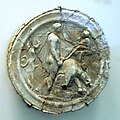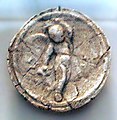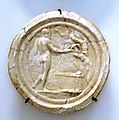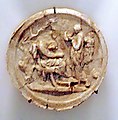Bagram
Bagram | |
|---|---|
 | |
| Country | |
| Province | Parwan Province |
| Elevation | 4,895 ft (1,492 m) |
| Time zone | + 4.30 |
Bagram or Bagrām (ancient Alexandria of the Caucasus, medieval Kapisa) was an ancient city located at the junction of the Ghorband and Panjshir valleys, near today's city of Charikar, Afghanistan. Its location made it a key passage into India along the Silk Road about 60 kilometers northwest of Kabul and towards Bamiyan
- (Note: In the Classical Era the Greeks called the Hindu Kush mountains the "Caucasus", in parallel to the Caucasus Mountains separating Europe and Asia.)
Alexandria was laid out in the Greek "hippodamian plan" and had brick walls reinforced with towers at the angles. The central street was bordered with shops and workshops.
History
It is unknown when the site was originally settled. In the mid 500s BC, Cyrus the Great of the Persian Achaemenid Dynasty destroyed the city, which was soon rebuilt by his successor Darius.
In the 320s BC, Alexander the Great captured the city and established a fortified colony named Alexandria of the Caucasus. After his death in 323 BC, the city passed to his general Seleucus, who traded it to the Mauryan Dynasty of India in 305 BC. After the Mauryans were overthrown by the Sunga Dynasty in 185 BC, the Greco-Bactrian Kingdom invaded and conquered northwestern India with an army led by Demetrius I of Bactria. Alexandria became a capital of the Eucratidian Indo-Greek Kingdom after they were driven out of Bactria by the Yuezhi in 140 BC.
Bagram (Kapisa) became the summer capital of the Kushan Empire in the 1st century, their other capital being in Mathura in central India.

The emperor Kanishka started many new buildings there. The central palace building yielded a very rich treasure, dated from the time of emperor Kanishka in the 2nd century: ivory-plated stools of Indian origin, lacquered boxes from Han China, Greco-Roman glasses from Egypt and Syria, Hellenistic statues in the Pompean style, stuc moldings, and silverware of Mediterranean origin (probably Alexandria).
The "Begram treasure" as it has been called, is indicative of intense commercial exchanges between all the cultural centers of the Classical time, with the Kushan empire at the junction of the land and sea trade between the east and west. However, the works of art found in Begram are either quite purely Hellenistic, Roman, Chinese or Indian, with only little indications of the cultural syncretism found in Greco-Buddhist art.
The city was apparently abandoned after the campaigns of the Sassanian emperor Shapur I, in 241.
-
Statue of Harpocrates, Begram, 2nd century.
-
Statuette of Serapis from Begram.
-
Statuette of the young Alexander the Great.
-
A Greco-Roman gladiator on a glass vessel, Bagram, 2nd century.
-
Begram vase fragments depicting a fighting scene.
-
Plaster mold from Begram.
-
Plaster mold from Begram depicting a cupid.
-
Plaster mold from Begram.
-
Plaster mold from Begram.
-
Plaster mold from Begram depicting a Greek soldier.
Today
As many other historical sites in Afghanistan, Bagram has been looted for old artifacts during the years following the overthrow of the Communist regime. Today, Bagram hosts the strategic Bagram Airfield from which most US air activity in Afghanistan takes place. There is also a Provincial Reconstruction Team which is led by the US.
Bagram is a district of Parwan Province.
See also
- Afghanistan
- Bagram torture and prisoner abuse
- Bagram Airfield
- NATO
- Provincial Reconstruction Team
- International Security Assistance Force
References and footnotes
- Afghanistan: Hidden Treasures from the National Museum, Kabul (2008). Eds., Friedrik Hiebert and Pierre Cambon. National Geographic, Washington, D.C. ISBN 978-1-4262-0374-9.











